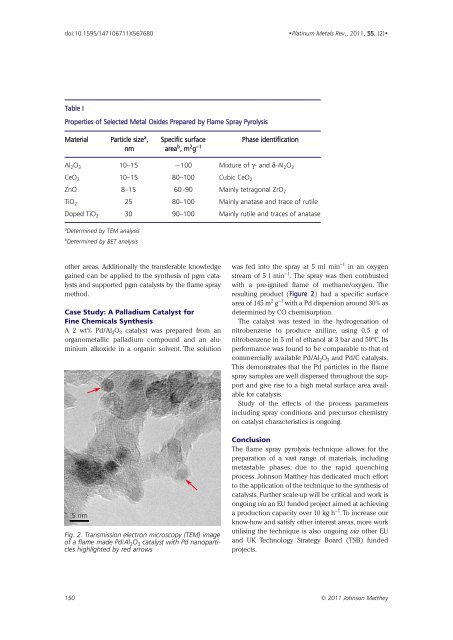Download - Platinum Metals Review
Download - Platinum Metals Review
Download - Platinum Metals Review
You also want an ePaper? Increase the reach of your titles
YUMPU automatically turns print PDFs into web optimized ePapers that Google loves.
doi:10.1595/147106711X567680<br />
•<strong>Platinum</strong> <strong>Metals</strong> Rev., 2011, 55, (2)•<br />
Table I<br />
Properties of Selected Metal Oxides Prepared by Flame Spray Pyrolysis<br />
Material Particle size a , Specific surface Phase identification<br />
nm area b , m 2 g −1<br />
Al 2 O 3 10–15 ~100 Mixture of γ- and δ-Al 2 O 3<br />
CeO 2 10–15 80–100 Cubic CeO 2<br />
ZnO 8–15 60–90 Mainly tetragonal ZrO 2<br />
TiO 2 25 80–100 Mainly anatase and trace of rutile<br />
Doped TiO 2 30 90–100 Mainly rutile and traces of anatase<br />
a Determined by TEM analysis<br />
b Determined by BET analysis<br />
other areas. Additionally the transferable knowledge<br />
gained can be applied to the synthesis of pgm catalysts<br />
and supported pgm catalysts by the flame spray<br />
method.<br />
Case Study: A Palladium Catalyst for<br />
Fine Chemicals Synthesis<br />
A 2 wt% Pd/Al 2 O 3 catalyst was prepared from an<br />
organometallic palladium compound and an aluminium<br />
alkoxide in a organic solvent. The solution<br />
5 nm<br />
Fig. 2. Transmission electron microscopy (TEM) image<br />
of a flame made Pd/Al 2 O 3 catalyst with Pd nanoparticles<br />
highlighted by red arrows<br />
was fed into the spray at 5 ml min −1 in an oxygen<br />
stream of 5 l min −1 . The spray was then combusted<br />
with a pre-ignited flame of methane/oxygen. The<br />
resulting product (Figure 2) had a specific surface<br />
area of 145 m 2 g −1 with a Pd dispersion around 30% as<br />
determined by CO chemisorption.<br />
The catalyst was tested in the hydrogenation of<br />
nitrobenzene to produce aniline, using 0.5 g of<br />
nitrobenzene in 5 ml of ethanol at 3 bar and 50ºC. Its<br />
performance was found to be comparable to that of<br />
commercially available Pd/Al 2 O 3 and Pd/C catalysts.<br />
This demonstrates that the Pd particles in the flame<br />
spray samples are well dispersed throughout the support<br />
and give rise to a high metal surface area available<br />
for catalysis.<br />
Study of the effects of the process parameters<br />
including spray conditions and precursor chemistry<br />
on catalyst characteristics is ongoing.<br />
Conclusion<br />
The flame spray pyrolysis technique allows for the<br />
preparation of a vast range of materials, including<br />
metastable phases, due to the rapid quenching<br />
process. Johnson Matthey has dedicated much effort<br />
to the application of the technique to the synthesis of<br />
catalysts. Further scale-up will be critical and work is<br />
ongoing via an EU funded project aimed at achieving<br />
a production capacity over 10 kg h −1 .To increase our<br />
know-how and satisfy other interest areas, more work<br />
utilising the technique is also ongoing via other EU<br />
and UK Technology Strategy Board (TSB) funded<br />
projects.<br />
150 © 2011 Johnson Matthey
















